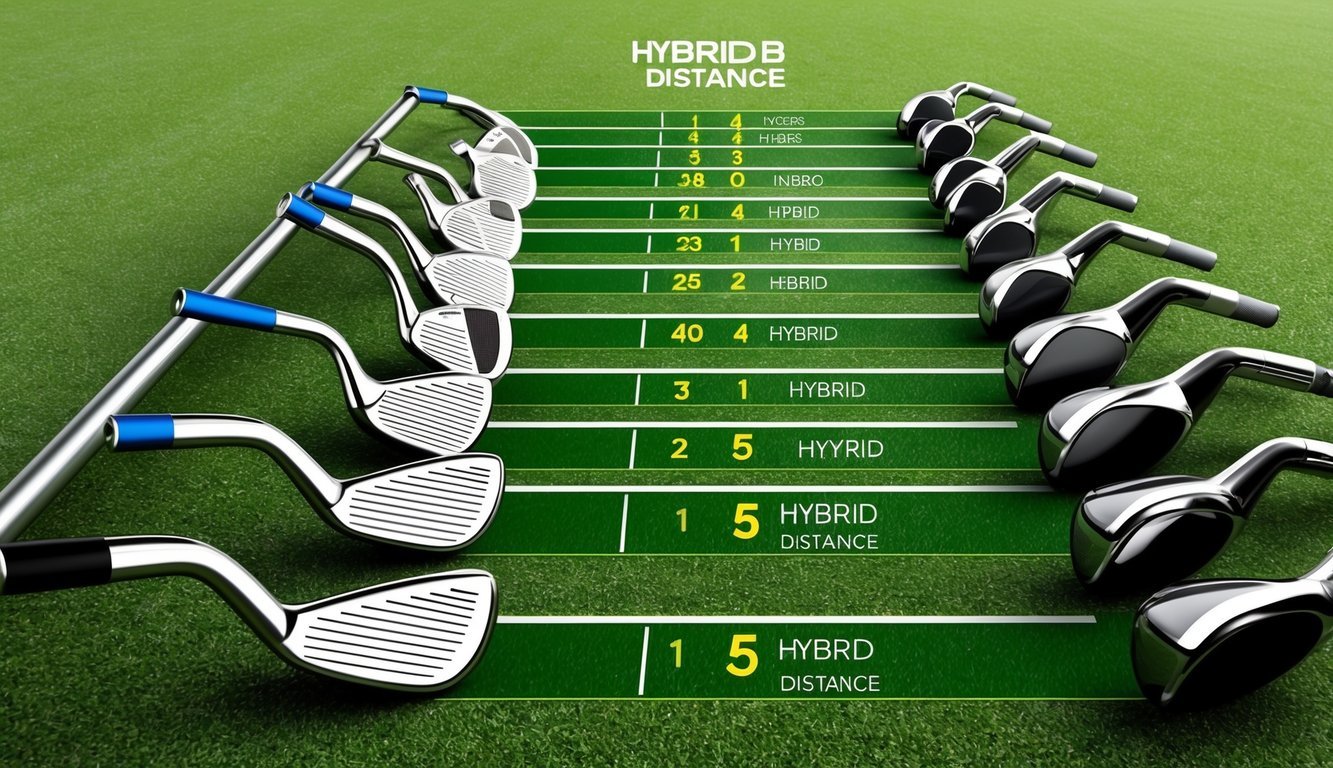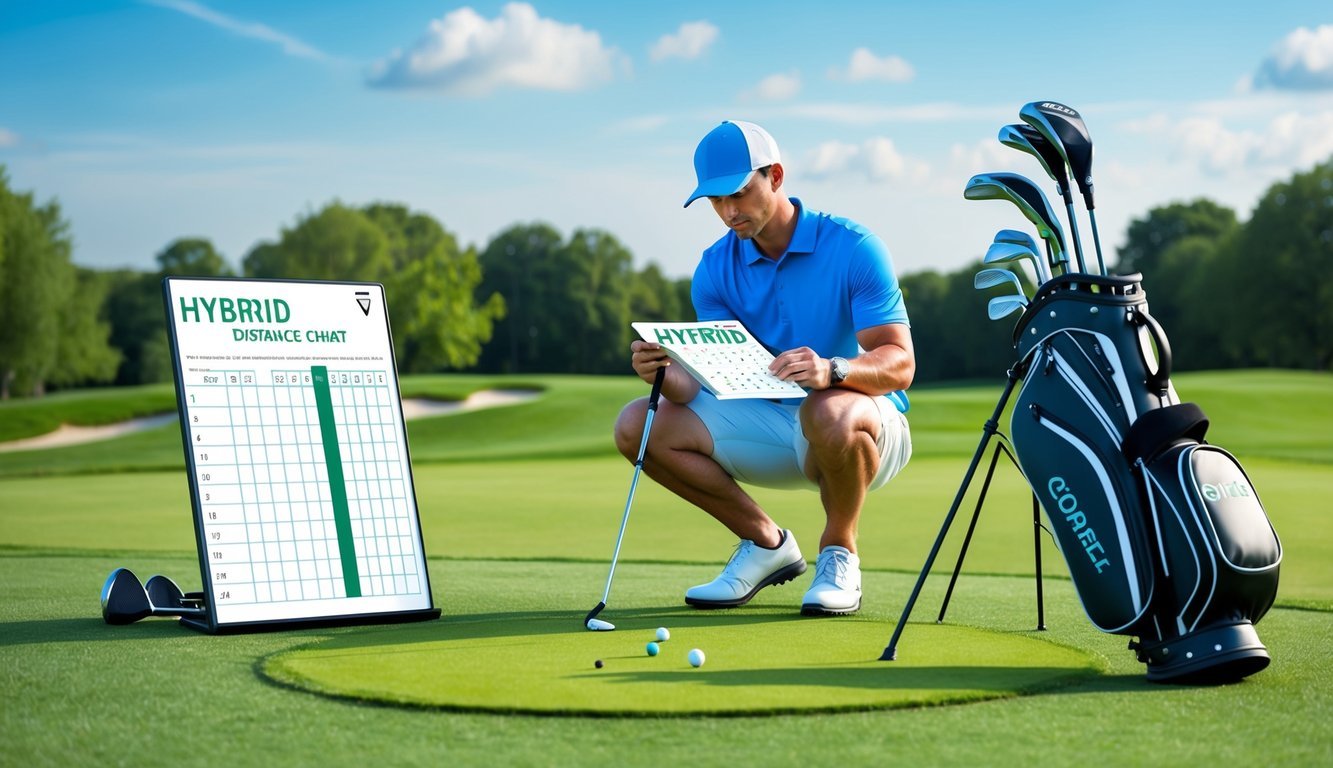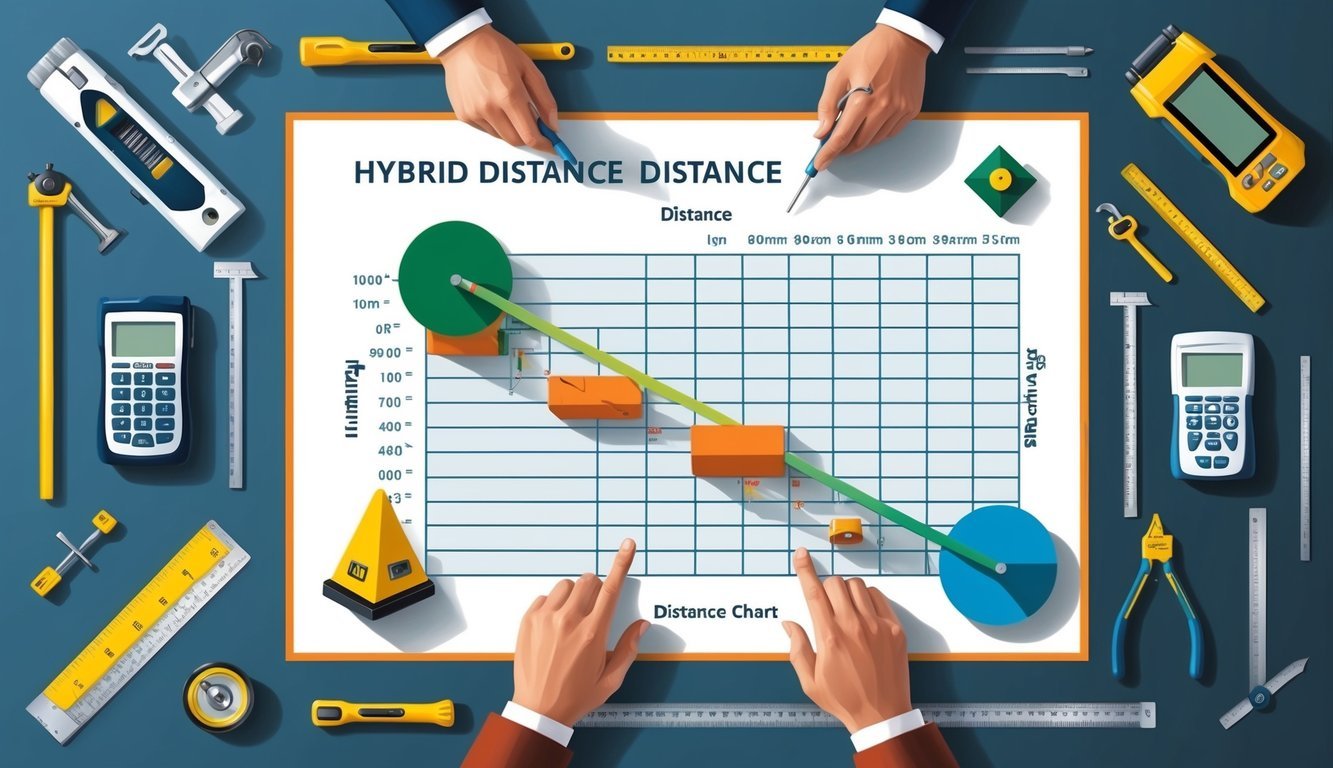Navigating the world of golf clubs can be a challenge, especially when it comes to hybrids.
These versatile clubs have become favorites among many golfers, offering a blend of power and precision that traditional irons sometimes lack.
The hybrid distance chart can give you valuable insight into how far each club in your bag can take you. This knowledge can significantly improve your performance on the course by helping you choose the right club for any shot.

As you dive into the metrics of hybrid clubs, it’s crucial to recognize how clubhead speed and loft angle impact your game.
Faster swings might mean greater distances, but precision is just as essential.
Tools such as GPS devices or apps can now assist you by providing exact data to refine your choices on the fairway.
Taking the time to familiarize yourself with these factors will help you make more confident decisions during play.
Understanding your hybrids better also means knowing the tools that measure their performance.
Technologies have evolved to offer golfers precise insights into distance and accuracy, minimizing guesswork.
Whether you’re a seasoned golfer or just starting, these insights can enhance your game on any course.
Key Takeaways
- Hybrid distance knowledge enhances club selection.
- Understanding metrics boosts your on-course performance.
- Technology aids in precise distance measurement.
Fundamentals of Hybrid Golf Clubs

Understanding hybrid golf clubs can transform your game by offering a blend of features from both irons and woods.
These versatile clubs help manage challenging shots, offering enhanced forgiveness and precision across various conditions.
Hybrid vs. Iron and Wood
When comparing hybrids with irons and woods, you’ll notice distinct differences. Hybrids, unlike irons, have a larger clubhead, providing a wider sweet spot.
This makes them forgiving and easier to hit, especially for the average golfer.
These clubs bridge the gap between irons and woods, with lofts similar to those of long irons but delivering the distance typically expected from woods.
Conversely, woods have a larger head and are designed for distance. Hybrids feature a shorter shaft length like irons, making them more controllable.
You’ll find hybrids beneficial in scenarios requiring precision over long distances, such as navigating the fairway or getting out of the rough.
Advantages of Using Hybrids
Hybrids offer several advantages that may appeal to golfers looking for improved distance control and ease of use.
These clubs feature a lower center of gravity, helping players to launch the ball higher.
The clubhead design facilitates smoother interaction with the turf, reducing the chances of a mishit.
Their construction makes hybrids forgiving, which is valuable on off-center hits.
This quality can significantly benefit golfers who struggle with traditional irons.
Additionally, the versatility of hybrids means they are just as effective from the fairway as they are from the rough.
The ease of swing and precision hybrids provide can help bolster your confidence in challenging situations.
Selecting the Right Hybrid
When choosing a hybrid, consider factors like loft, shaft length, and your specific playing style.
Hybrids typically have a loft range similar to that of longer irons, making them suitable replacements for clubs you find difficult.
Understanding the loft is crucial, as it determines the ball trajectory and distance.
It’s important to have hybrids that match your needs and complement your existing golf club set.
Pay attention to the shaft length, as this affects control and distance.
Ensure the club’s weight and balance feel comfortable in your hands.
By focusing on these attributes, you can select hybrids that improve your performance regardless of the course.
Understanding Distance Metrics
When analyzing hybrid golf clubs, it’s essential to understand how different factors impact the distances achieved.
Metrics vary for men and women due to differing swing speeds and techniques, and conditions such as swing mechanics and ball flight also play a significant role.
Golf Club Distances for Men and Women
Men typically hit hybrid clubs farther than women, primarily due to higher swing speeds.
On average, a man using a 2-hybrid can expect distances between 180-210 yards, while using a 3-hybrid might reach 170-200 yards.
For women golfers, distances are usually shorter.
A 2-hybrid might cover 160-190 yards.
These variations arise from differences in swing mechanics and ball speed, which influence how far the golf ball travels.
Here’s a simple comparison:
| Club | Men (Yards) | Women (Yards) |
|---|---|---|
| 2-Hybrid | 180-210 | 160-190 |
| 3-Hybrid | 170-200 | 150-180 |
Understanding these averages can help you choose clubs that best fit your game style and ability.
Factors Influencing Distance
Several elements can affect how far you hit your hybrid clubs.
Your swing mechanics are crucial; a more fluid and controlled swing typically results in better distances.
Pay attention to your stance and technique as they directly impact the ball flight and trajectory.
Environmental elements also have their say. Wind can significantly alter how far the ball travels, either aiding or hindering its progress.
Additionally, the golf ball you use makes a difference—some balls are designed for greater distance, while others offer more control.
Finally, monitor your swing speed: a faster swing generally translates into greater distances, although maintaining control is essential.
By focusing on these factors, you’ll be better equipped to optimize your hybrid club performance and improve your game.
Improving Your Game with Hybrids

Hybrids offer both versatility and consistency on the golf course, making them valuable tools for approach shots and off-the-tee plays.
Mastering control, accuracy, and precision with hybrids can boost your confidence and enhance your game.
Techniques for Better Control and Accuracy
When using hybrids, focusing on swing mechanics is crucial for both control and accuracy.
A steady swing helps maintain consistency in your shots.
Start by positioning the ball slightly forward in your stance.
This position promotes a clean strike, reducing the risk of hitting the turf before the ball.
Next, consider your grip.
A firm grip ensures stable clubhead contact, which aids in controlling the trajectory.
Adjust your grip pressure for better feel and easier manipulation of club-face angle, affecting the launch angle and distance.
Remember to keep your movements smooth and rhythmic, which contributes to improved precision.
A consistent tempo throughout your swing enhances control, ensuring your energy transfers effectively to the ball.
Practice Tips for Mastering Hybrids
Dedicate practice sessions to hybrids to develop familiarity and confidence.
Start with small swings, gradually increasing to full swings to understand how different tempos affect accuracy and distance.
Practicing regularly builds muscle memory, leading to better shot consistency.
Play with the launch angle by altering your tee height or stance foot positioning.
Experimenting in practice helps you learn how these adjustments impact your shot outcomes during actual play.
Consider practicing on different terrains and conditions.
This versatility in practice prepares you for real-world situations, where lie conditions can vary significantly.
Incorporate approach shots from varied distances to improve your adaptability and confidence with hybrids.
Tools and Technologies for Measuring Distance

In modern golf, knowing the precise distance each club can achieve is essential for improving your game.
This section covers the various tools that can help you measure distance accurately and technology that can analyze your swing.
Distance Measuring Devices
Various distance measuring devices can help you better understand the range of your golf clubs. GPS devices are popular choices, offering a wealth of information about the golf course, including distances to the green and hazards.
Rangefinders are another useful tool, often favored for their accuracy.
They use laser technology to provide you with the exact distance to your target. Wearable technology, like watches with built-in GPS, offer convenience by keeping your hands free.
These devices can easily fit into your golf bag without taking much space, making them practical additions to your golfing equipment.
Analyzing Swing and Distance with Tech
Understanding your swing speed and ball speed can greatly impact your distance control. Swing analysis apps and devices can provide valuable insights into your swing mechanics.
Meanwhile, launch monitors are equipped with advanced sensors to track the ball’s speed, angle, and trajectory after a golf shot, giving you detailed feedback on your performance.
Many of these technologies connect to a smartphone app, offering you a comprehensive view of your game over time.
They can help identify patterns and areas for improvement, thus allowing you to choose the right golf club for each situation confidently.
Making the Most of Your Hybrids on the Course
Hybrids are versatile clubs that fill the gap between long irons and fairway woods, offering unique benefits for various situations on the course.
Effectively using hybrids involves strategic club selection and honing your shot-making skills to handle diverse scenarios.
Course Management Strategies
When managing the course, hybrids can be your best allies for navigating tricky spots and enhancing your shot strategy.
Use a 3-hybrid or 4-hybrid for long approach shots, as they offer better control and distance than long irons.
These clubs are particularly effective in reaching greens on par-5s or long par-4s when fairway woods might be too much club.
Hazards play a critical role in determining when to pull out your hybrid.
If there’s a risk of hitting into a bunker or water, opt for a hybrid to stay short of the trouble.
Positioning the ball well in your stance with a smooth swing can ensure consistent contact and better outcomes.
Rely on hybrids to bypass more challenging obstacles while maintaining a softer approach than a driver from the tee.
Hybrids for Different Types of Shots
Hybrids shine across various shot types, offering options for both tee shots and recovery play.
On narrow fairways or when accuracy is crucial, a hybrid can be a reliable choice.
Unlike fairway woods, hybrids facilitate easier launches with high arcs, making them ideal for tight lies or when you need precision.
These clubs perform well in rough or tricky lies where long irons might struggle.
For example, the 5-hybrid can be particularly helpful for approach shots from the rough where control is essential.
In sand or nestled in the grass, the club’s design helps cut through difficult surface conditions, allowing you to maintain accuracy.
By understanding these capabilities, you can maximize your hybrids’ potential throughout different stages of your game.

